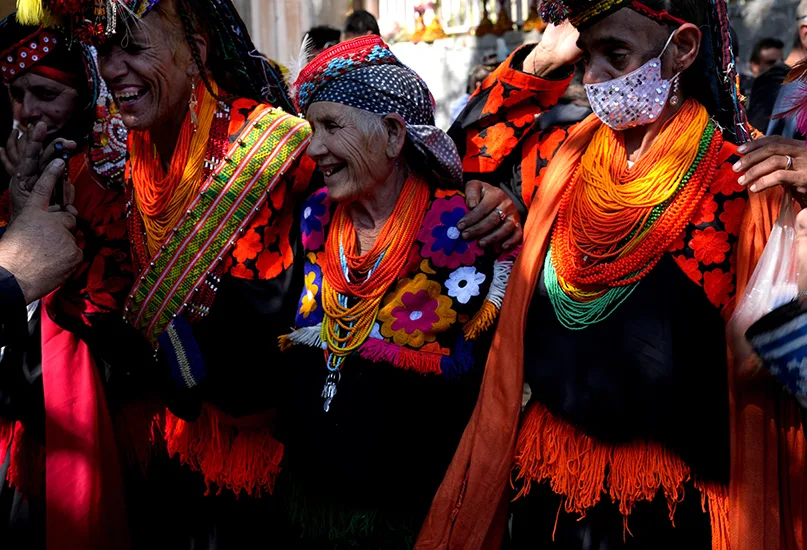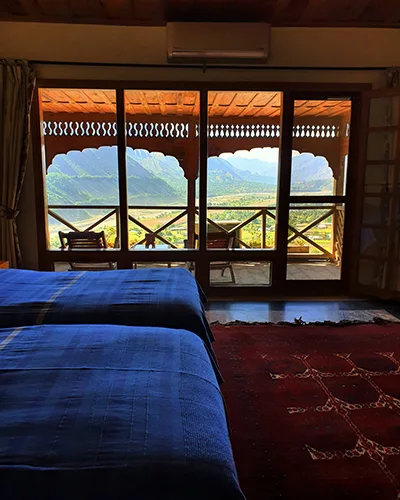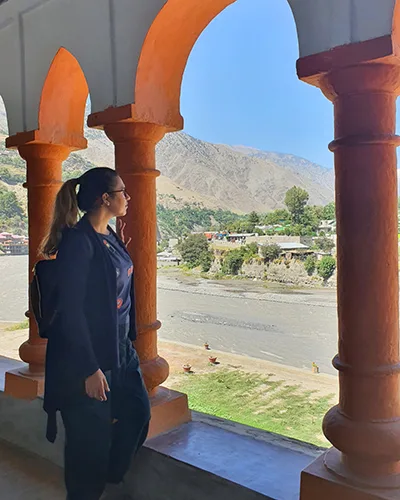Pakistan’s Kalash Valley in the Chitral District is home to the Kalashi people, a remote pagan tribe. However, during my visit, I learned their traditions and future are under threat from the impact of tourism.
A CHANGING LANDSCAPE
As the Chitral River flowed, a man began to play his flute, and the woman beside him, adorned in heavily embellished clothes, abandoned her washing at the riverbank, stepped back, and started to dance to the melodic music.
Once she decided she was done, she continued her washing. As if no disruption had been made in the valley, nature continued its course – the wind blew through the trees, and the birds chirped on.
That was the serenity that once existed in Chitral’s Kalash Valley. My family, who are avid travellers, recount this incident with great fascination. Chitral was a place of natural movement and a peaceful lifestyle, wholly cut off from the modern world about 33 years ago.
Today, despite being armed with the conveniences of modern facilities, the town is bombarded with tourists each year.

ARRIVAL AND ACCOMMODATION
As the sun had just started to rise, the bus suddenly came to a halt. The driver, who had gotten off the bus and vanished into the crowd up ahead, came back to inform us of the situation.
We were told a stream had gushed down the mountain and blown the whole road apart. Furthermore, we would have to wait a while for the excavator to get here.
Eventually, a temporary path was made, solid enough to cross to the other side. A 4×4 vehicle waited to take me to the Chitral Valley, where I was heading to meet a remote pagan tribe – the Kalashi people.
Crossing the scenic valley – where I held my breath at each sharp turn in the road, praying the vehicle would not go down the steep fall below – we finally arrived at the hotel.
The family who runs the hotel came out to warmly greet me, enquiring about the delay in the journey. I couldn’t help but notice that the gentleman wore a symbol on his hat, the same one that previous Mehtars of the region had worn on their royal headpieces, which I assumed was his entitlement to wear as a prince of the royal family.
The Mehtar of Chitral is the noble title given to the region’s ruler, however, it’s mostly a ceremonial role these days.
The Hindukush Heights hotel itself was a pleasant surprise. Built on the granite mountain’s side, the hotel’s rear overlooked the breathtaking view of the Chitral Valley and its river.
The rustic grandeur of the hotel was decorated in traditional Chitrali wooden furniture, with handmade rugs and kilims sprung around on every corner. I immediately thought how regal it looked, perhaps a nod to the establishment’s ownership.
Looking at all the historical and cultural artefacts lining the hallways, I couldn’t help but feel excited about what I had organised for the next day.


KALASHI CULTURE
I had heard and extensively read about the Kalashi people and was eager to finally travel to this part of the country to visit this unique pocket of Pakistani culture.
Everything about the Kalashi people seems to be at variance with the rest of the country. The landscape of the Hindu Kush mountains, where the Kalash Valley resides, is a rugged mountain range that is quite different in terms of the landscape from the other two ranges in Pakistan – the Himalayas and the Karakoram, which are verdant in contrast.
The Kalashi’s religion is also different, with 3,000 or so worshippers left following a pagan belief rooted in honouring and remembering ancestors. With fairer skin and lighter eyes, their aesthetic is distinct from that of the rest of the population.
Many Kalashi people have, over time, left their culture and religion and have become more modernised, despite a few still firmly holding onto their cultural norms in a fast-changing world.
My grandfather visited the valley in 1991 at a time when not many ventured past the hostile landscape nor even knew about this distinctive group.
When my family visited about 33 years ago, tourists rarely frequented the area; in fact, the Kalash Valley was so remote that the locals didn’t speak a word of Urdu, Pakistan’s national language.
The next day, when I set out to visit the valley, the hotel had connected me with a Kalashi girl guide to show me around. I soon realised how the town had become a tourist trap, especially the market, which was lined with souvenir shops.
I was then shown the temple’s exterior (non-Kalashi people are not allowed to enter), the town centre, and the menses centre (during their cycle, Kalashi women must remain in the building and not exit it). Each location offered a glimpse into the Kalashi people’s traditions and everyday lives.


TRANSITIONING TRADITIONS
In addition to my family’s stories about their impressions of the Kalashi people, my understanding of them prior to my visit was shaped by The Kafirs of the Hindu Kush, a book written by Sir George Scott Robertson.
He wrote one of the first detailed accounts of the Kafirs (now known as Kalashis) based on his extensive experiences living with the tribe in 1896 during British rule in India.
Robertson remarked that the Kalashi civilisation abruptly fell asleep centuries ago in Kafaristan and is still dormant.
In his books, Robertson describes them as a primitive tribe, entirely cut off from the rest of the world, even though there are recorded encounters between the tribe and Timurlane, as well as with Babur, the first Mughal emperor.
He also observed that their present ideas, history, and religious associations are “simply bloodshed, assassination, and blackmailing, yet they are not savages. Some of them have the heads of philosophers and statesmen”.
As the tour guide showed us around, her daughter eventually joined us, and I was proudly informed that she had learned to speak English through cartoons on her mother’s phone. It was another difference from nearly three decades ago when hardly anyone spoke the national language.
The conversation then shifted to how the Kalash Valley had changed over the years. The guide shared her frustration with me at how the rest of the country thought of them as underdeveloped, belonging to a religion far removed from their belief systems.
Ending the topic on a lighter note, I pointed out how the clothing had changed over the years, as on the book cover of Robertson’s publication, the front page displayed a girl wearing black clothes with dark green and red hand embroidery, a furry hat, and a black substance rubbed on her face around the eyes. The girl told me that, nowadays, they are all very fashion-conscious and adopt a new style during each festival, with their florescent machine embroidery changing each season.

TRADITIONS AND TOURISM COLLIDE
On the drive back to the hotel, the driver, a Chitrali man, told me there were only some 3,000 Kalashi people left because their religion was challenging to maintain. The women would often elope with men during the festival season or go to the big cities to study and convert to another religion.
In Kalashi culture, women are expected to always be adorned in heavy and embroidered clothes and must sacrifice a goat for every possible milestone in life, making it quite an expensive religion to follow.
Whilst the culture has modernised in some ways, such as having a menses centre in town and not being located within a cave up in the mountains as was the case in the near past, the liberation of the outside world perhaps seems worth it to leave the familiarity of their culture, never being able to return. It has become quite common now for a Muslim and a Kalashi brother to coexist in the same household.
With the rise of globalisation and the development of better road networks – all with modern machinery for road maintenance – the influx of festival visitors dramatically contributes to the local economy. However, the once-serene atmosphere of the valley seems to have disappeared.
In the age of modernisation, although they have access to education and better healthcare, the Kalashi people are also slowly losing their cultural identity. This raises concerns about embracing modernity and maintaining the unique Kalashi heritage and traditions, as the reliance on tourism to bolster the economy may not be sustainable.


THE KALASHI PEOPLE’S RARE RITUAL
The girl guide asked me if I wanted to visit a graveyard, but I hesitated as the Kalashi people have a unique style of burying their dead. Their graveyard, up in the mountains, is scattered with open coffins, offering the corpse back to nature so that birds may come along and peck at the human remains. I had often been told that a family member vomited during their last visit after looking in an open coffin.
The Kalashi girl, noticing my reluctance again, asked if I wanted to see the graveyard, and at her insistence, I finally agreed. I soon realised that this newer burial ground was in the town centre and had been set up for tourists, as open coffins seemed to be neatly and strategically placed, with a boardwalk going around the graves and a signboard on display.
In addition to the unique custom of disposing of the dead, the Kalashi people prepare lavish meals and feed all guests who come to the funeral to express their solidarity with the bereaved family. The affair is expensive, and most community members contribute to the occasion.
The Kalashi people also blow whistles, sing, dance, and beat drums around the body before taking it for burial, and they believe Sajigor, the god of death, prefers celebration over mourning at the time of passing.
When inquiring about the burial method, the guide responded that it was now obsolete. Today, interments are underground to avoid air pollution due to population growth.






















